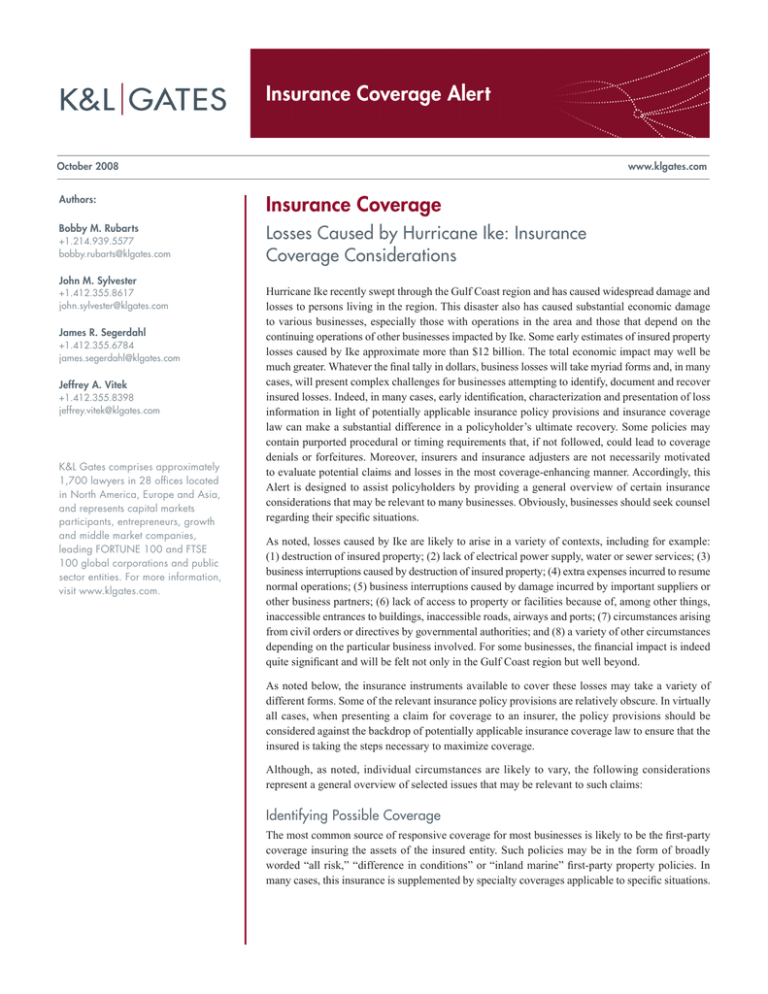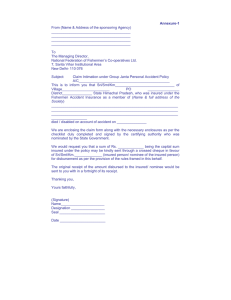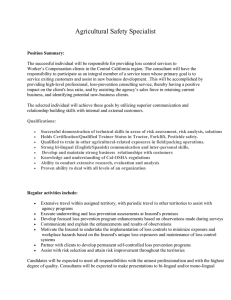
Insurance Coverage Alert
October 2008
www.klgates.com
Authors:
Insurance Coverage
Bobby M. Rubarts
Losses Caused by Hurricane Ike: Insurance
Coverage Considerations
+1.214.939.5577
bobby.rubarts@klgates.com
John M. Sylvester
+1.412.355.8617
john.sylvester@klgates.com
James R. Segerdahl
+1.412.355.6784
james.segerdahl@klgates.com
Jeffrey A. Vitek
+1.412.355.8398
jeffrey.vitek@klgates.com
K&L Gates comprises approximately
1,700 lawyers in 28 offices located
in North America, Europe and Asia,
and represents capital markets
participants, entrepreneurs, growth
and middle market companies,
leading FORTUNE 100 and FTSE
100 global corporations and public
sector entities. For more information,
visit www.klgates.com.
Hurricane Ike recently swept through the Gulf Coast region and has caused widespread damage and
losses to persons living in the region. This disaster also has caused substantial economic damage
to various businesses, especially those with operations in the area and those that depend on the
continuing operations of other businesses impacted by Ike. Some early estimates of insured property
losses caused by Ike approximate more than $12 billion. The total economic impact may well be
much greater. Whatever the final tally in dollars, business losses will take myriad forms and, in many
cases, will present complex challenges for businesses attempting to identify, document and recover
insured losses. Indeed, in many cases, early identification, characterization and presentation of loss
information in light of potentially applicable insurance policy provisions and insurance coverage
law can make a substantial difference in a policyholder’s ultimate recovery. Some policies may
contain purported procedural or timing requirements that, if not followed, could lead to coverage
denials or forfeitures. Moreover, insurers and insurance adjusters are not necessarily motivated
to evaluate potential claims and losses in the most coverage-enhancing manner. Accordingly, this
Alert is designed to assist policyholders by providing a general overview of certain insurance
considerations that may be relevant to many businesses. Obviously, businesses should seek counsel
regarding their specific situations.
As noted, losses caused by Ike are likely to arise in a variety of contexts, including for example:
(1) destruction of insured property; (2) lack of electrical power supply, water or sewer services; (3)
business interruptions caused by destruction of insured property; (4) extra expenses incurred to resume
normal operations; (5) business interruptions caused by damage incurred by important suppliers or
other business partners; (6) lack of access to property or facilities because of, among other things,
inaccessible entrances to buildings, inaccessible roads, airways and ports; (7) circumstances arising
from civil orders or directives by governmental authorities; and (8) a variety of other circumstances
depending on the particular business involved. For some businesses, the financial impact is indeed
quite significant and will be felt not only in the Gulf Coast region but well beyond.
As noted below, the insurance instruments available to cover these losses may take a variety of
different forms. Some of the relevant insurance policy provisions are relatively obscure. In virtually
all cases, when presenting a claim for coverage to an insurer, the policy provisions should be
considered against the backdrop of potentially applicable insurance coverage law to ensure that the
insured is taking the steps necessary to maximize coverage.
Although, as noted, individual circumstances are likely to vary, the following considerations
represent a general overview of selected issues that may be relevant to such claims:
Identifying Possible Coverage
The most common source of responsive coverage for most businesses is likely to be the first-party
coverage insuring the assets of the insured entity. Such policies may be in the form of broadly
worded “all risk,” “difference in conditions” or “inland marine” first-party property policies. In
many cases, this insurance is supplemented by specialty coverages applicable to specific situations.
Insurance Coverage Alert
While there are standard insurance industry forms for the
coverage, some insurers have issued tailored policies to meet
an insured’s particular risk scenarios. Evaluation of specific
policy language in light of applicable state insurance law
is critical. As a general matter, first-party coverage often
includes the following specific elements:
• “property damage” coverage with respect to any property
that may be classified as “insured property,” which often
is broadly defined by the policy or applicable law;
• “business interruption” coverage, which generally covers
the insured’s loss of earnings or revenue resulting from
property damage caused by an insured peril;
• “service interruption” coverage, which generally covers
the insured for losses related to electric or other power
supply interruptions;
• “contingent business interruption” coverage, which
generally covers the insured with respect to losses,
including lost earnings or revenue, as a result of damage
to property of a supplier, a customer or some other
business partner or entity;
• “extra expense” coverage, which generally covers the
insured for certain extra expenses incurred by the insured
as a result of an insured event and in order to resume
normal operations and mitigate other losses;
• “civil authority” coverage, which generally covers
the insured for losses arising from an order of a
governmental authority that interferes with normal
business operations;
• “defense” coverage, which generally covers the insured
for defense costs incurred with respect to claims alleging
that the insured is responsible for damage to covered
property of others;
• “ingress and egress” coverage, which generally covers
the insured when access to a business premises or
location is blocked for a time;
• “claim preparation” coverage, which generally covers
the insured for the costs associated with compiling and
certifying a claim.
As noted, in addition to these coverage features often set
forth in typical first-party property policies, many businesses
may well have specialty policies potentially responsive to
particular situations as well. Moreover, an insured must
consider whether excess insurers should be involved. Thus, it
is important for an insured to make certain that all potentially
responsive insurance policies and policy provisions are
considered and evaluated as a potential source of recovery.
Presenting a Claim
Most policies purport to identify specific procedures that
should be followed in presenting a claim (notice, proof of
loss, suit limitation, etc.), and some of these procedures may
have timing deadlines associated with them. Moreover, the
manner in which a claim is presented may have an impact
on the ultimate recovery. For example, policies may have
different deductibles depending on the particular peril
causing the loss (whether wind, flood, or some other direct
circumstance), and the manner in which the policyholder
presents the claim could impact which particular deductible
is applied. Deductibles (and limits) may also be expressed
“per occurrence” or “per loss” or in other ways, and,
again, presentation of the claim could affect the number of
deductibles applied or the amount of the limits available.
Policies may also have specific exclusions applicable to
certain perils or circumstances that the insured should take
into account in presenting its claim. In all cases, an insured
should promptly collect and document its loss information,
evaluate the information in light of the policy wording and
applicable law, and present it to the appropriate insurer or
insurers in a timely and coverage-promoting manner. It is
often advisable or necessary to retain forensic accountants
to assist in preparing and certifying a claim, and the costs
associated with such an effort may be covered under the
policy. If purported deadlines have passed, the insured’s
pursuit of an insurance claim is not necessarily foreclosed. It
may be that the insurer must show that it was prejudiced by
an insured’s failure to meet a timing deadline before coverage
will be precluded on this basis.
Common Insurer Responses
Insurers may raise any number of issues in response to a
property damage or business interruption claim submitted
by a policyholder. Issues raised by insurers may include the
following:
• Was the damage to insured property caused by an
“insured peril”? Many first-party property policies are
written on an “all risk” basis, meaning that virtually
any cause of property damage is within the scope of
the policy except those causes that are specifically and
unambiguously enumerated in exclusions. Accordingly,
although some policies may expressly exclude or limit
October 2008 | 2
Insurance Coverage Alert
coverage for damage caused by “flood” or “windstorm,”
this fact is not necessarily determinative when damage
or loss may be the result of multiple causes. As noted,
policies also sometimes contain particular provisions
promising coverage for losses resulting from particular
specified events such as orders of a “civil authority” or
lack of ingress or egress. A policyholder’s particular loss
circumstances and policy language should be evaluated
in considering whether coverage may be available even
if an exclusion may appear to apply to certain aspects of
the loss.
• Did an “interruption” of business result? While insurers
sometimes take a narrow view of what may constitute an
“interruption,” generally an insured may have a claim,
depending on the circumstances, in any instance where
its income is adversely affected by an insured event.
• Was the interruption necessary? In many cases, this is
not a controversial issue. In some cases, the insurer could
question whether the claimed interruption is the result of
a routine business decision as opposed to a “necessary”
interruption under the circumstances.
• For business interruption claims, did the alleged loss
of income or extra expense arise out of damage to
“insured property”? It is not always necessary that
the relevant “property damage” occurred to property
owned by the insured. “Insured property” is sometimes
broadly defined by policy language or law to include
other property in which the insured may be said to
have an “insurable interest.” Many policies explicitly
or implicitly also promise coverage when a supplier, a
customer or, depending on the policy language, some
other entity incurs property damage that results in an
interruption of the insured’s business. Such coverage is
sometimes known as “contingent business interruption”
coverage and is often very broad. Similarly, there may
be arguments for coverage where anticipated business
was foreclosed in light of circumstances created by civil
orders or inaccessible ports, roads and closed airports.
• In the case of a claim resulting from loss of income or
extra expenses associated with loss of electrical power or
other service, did the interruption result from damage by
an insured peril to property of the provider of the service?
Some policies purport to exclude business interruption
coverage arising from interruptions in electrical service
(assuming the interruption is the controlling “cause”
of the loss). Other policies have language explicitly
promising time element coverage for losses arising out
of service interruptions (including service interruptions
to suppliers of the insured) but purport to require that
the interruption resulted from damage to property of
the service provider. In such a case, the circumstances
and cause of the interruption, including whether the
circumstances and cause can be characterized as resulting
from damage to property of the service provider, may be
critical to the availability of coverage. Policy language
in this context varies considerably, however, and an
insured must review carefully its own policy to assess
the availability of time element coverage arising out of
service interruption.
• Does the loss meet any requirements the policy may have
regarding duration of the interruption? Some policies
have language limiting coverage to interruptions that
extend for longer than a specified period of time.
• How long is the allowed “recovery period”? Policies
sometimes include provisions specifying that the policy
will only cover loss of income and related expenses for
a specified period of time after an insured event occurs.
This time frame frequently is tied to the time it would
take the insured, employing reasonable efforts, to resume
normal business operations under the circumstances.
• How many “occurrences” are implicated by the
alleged loss? As noted above, many policies have “per
occurrence” deductibles or other self-insurance features
that may reduce the amount of coverage available
depending on how the “number of occurrences” issue
is addressed. This issue may also impact the amount
of per-occurrence policy limits that are available to
the insured.
October 2008 | 3
Insurance Coverage Alert
Evaluating and Challenging Insurer Positions
The validity of any defenses or limitations to coverage
raised by insurers may well vary from state to state because
the courts of different states have developed differing
approaches to coverage issues presented by business
interruption claims. It is not always clear which state’s law
will apply to a coverage dispute. Moreover, the applicability
of these potential defenses will also depend a great deal
on the specific language used in the policy. Experienced
insurance coverage counsel may be able to assist an insured
in assessing the viability and strength of its potential claim
and in maximizing the insured’s potential insurance recovery.
It is often advantageous for an insured to obtain the advice of
coverage counsel at an early stage of the claim-submission
process to ensure that the claim is being presented to the
insurer in an optimum, coverage-promoting manner.
K&L Gates comprises multiple affiliated partnerships: a limited liability partnership with the full name K&L Gates LLP qualified in Delaware and
maintaining offices throughout the U.S., in Berlin, in Beijing (K&L Gates LLP Beijing Representative Office), and in Shanghai (K&L Gates LLP Shanghai
Representative Office); a limited liability partnership (also named K&L Gates LLP) incorporated in England and maintaining our London and Paris
offices; a Taiwan general partnership (K&L Gates) which practices from our Taipei office; and a Hong Kong general partnership (K&L Gates,
Solicitors) which practices from our Hong Kong office. K&L Gates maintains appropriate registrations in the jurisdictions in which its offices are
located. A list of the partners in each entity is available for inspection at any K&L Gates office.
This publication/newsletter is for informational purposes and does not contain or convey legal advice. The information herein should not be used or
relied upon in regard to any particular facts or circumstances without first consulting a lawyer.
Data Protection Act 1998—We may contact you from time to time with information on K&L Gates LLP seminars and with our regular newsletters,
which may be of interest to you. We will not provide your details to any third parties. Please e-mail london@klgates.com if you would prefer not to
receive this information.
©1996-2008 K&L Gates LLP. All Rights Reserved.
October 2008 | 4





